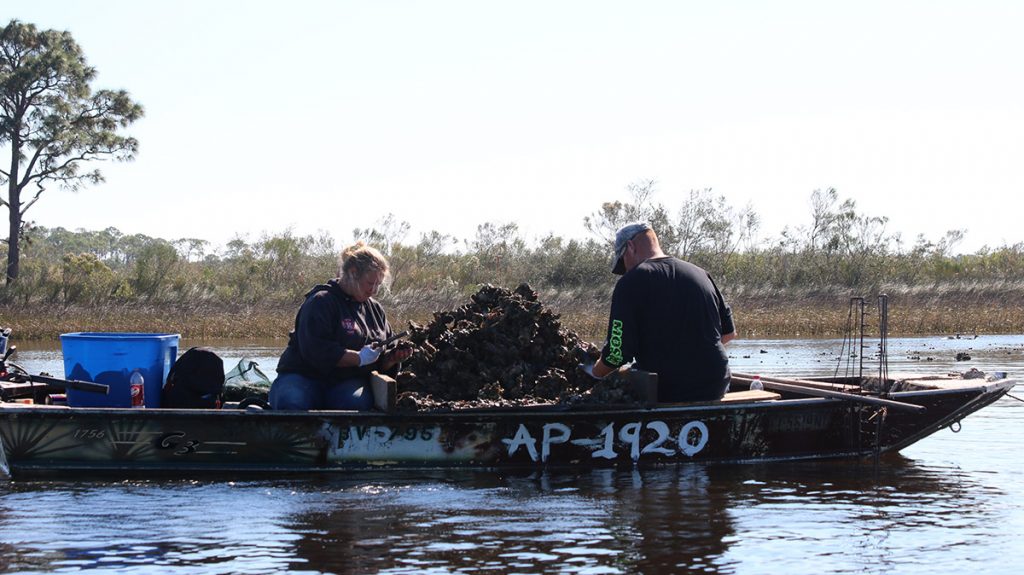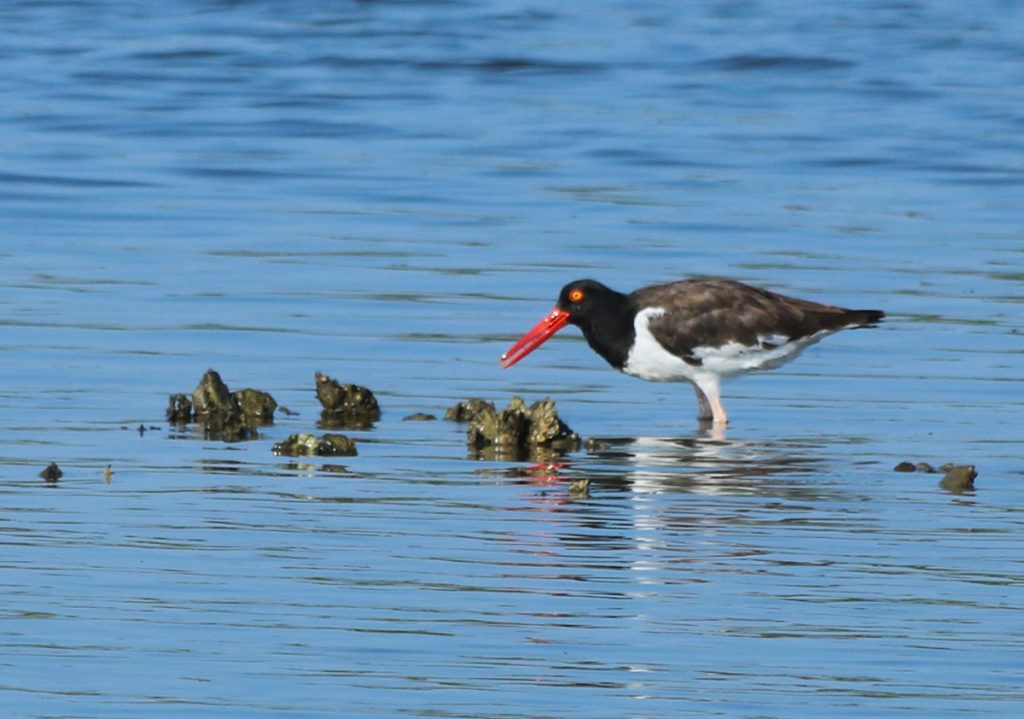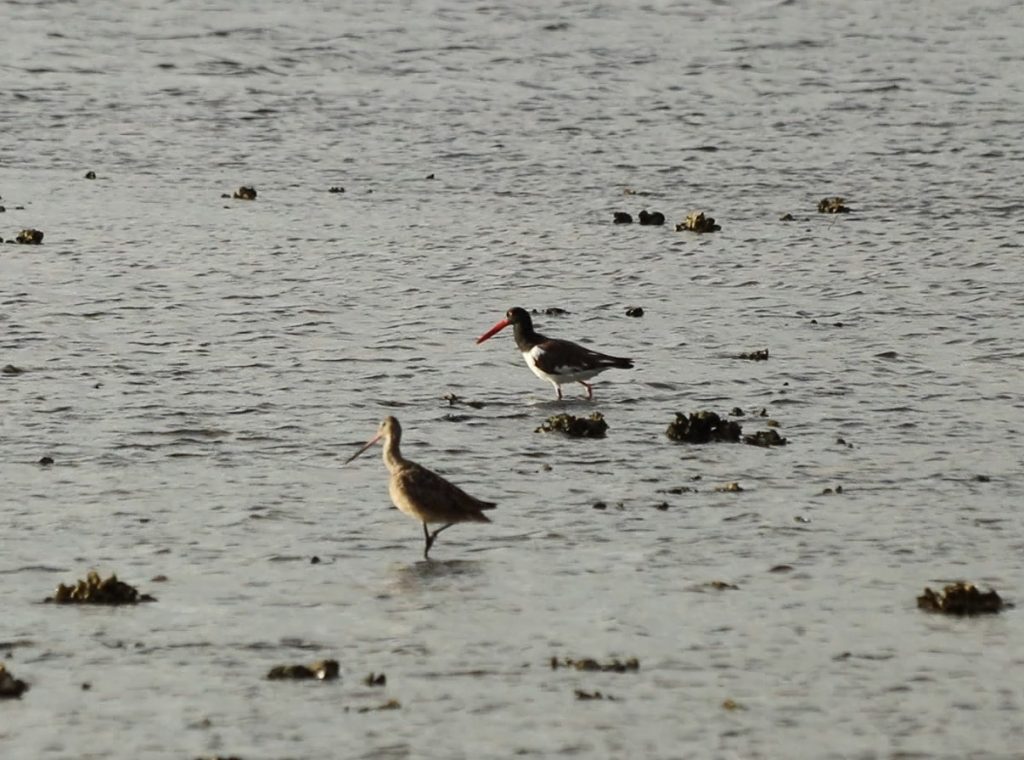After the tide swallows the sand bar off of Bald Point, we walk over to the oyster reefs. A few foraging birds poke the sprinkling of oysters still above water; we end up counting seven oystercatchers. Susan Cerulean notices that a couple of them are grown chicks. “It’s got a dusky bill,” she says as I train my camera on one. “That’s how I can tell.”
During our interview, least terns are squeaking over our heads. Nearby, a marbled godwit plunges its long bill into the wet sand, extracting a worm. It’s mid-July, and the godwit is at the leading edge of the winter migration. It’s not a bad morning of birding: two state-threatened species, evidence of successful breeding, and an early migrant. Bald Point State Park’s salt marshes, oyster reefs, and sand flats give these birds the space they need to eat and raise young. But this kind of habitat is becoming increasingly rare, and shorebirds across North America are feeling it.
“You can’t see the losses out here right now.” Susan says. “It looks pretty pristine. It’s like, wow, yay! Seven oystercatchers! The least terns are feeding, and we saw a black skimmer. There’s two godwits, and that’s great. But these birds, these shorebirds, since 1970, have lost seventy percent of their numbers.”
Loss is at the center of Susan’s new book, I Have Been Assigned the Single Bird: A Daughter’s Memoir. The loss of shorebirds and coastal ecosystems, but also loss within her family.
“De (undoing) plus mens (the mind). That’s Dementia.”
“At the time [covered in the book], I was doing two things.” Susan says. “I was taking care of my father, who had moved to Tallahassee because he had mid-stage dementia. And I was also volunteering as a steward of shorebirds on a little spoil island off of Apalachicola. On that island there were only a few birds nesting, and I had my one dad, so it just developed into a lot of thinking about those two things.”
During this time in her life, she was transitioning from working for Florida Fish and Wildlife to writing about nature full time, and volunteering. She and her husband, FSU Oceanographer Dr. Jeff Chanton, began to notice sea level rise eating away at our coastlines. That is, in fact, the focus of my previous stories with the two of them.
Susan also began to notice the ways in which shorebirds shared the coast with humans who often paid them no mind, and as a result put snowy plovers, least terns, and oystercatchers in a precarious position.
It’s a book about dementia: the literal dementia of her father’s last years, but also that of the human race and its relationship to the planet it calls home.
When you have the physical disease, you experience it alone. But our cultural dementia- we are in this together.”
Susan Cerulean, I Have Been Assigned the Single Bird: A Daughter’s Memoir
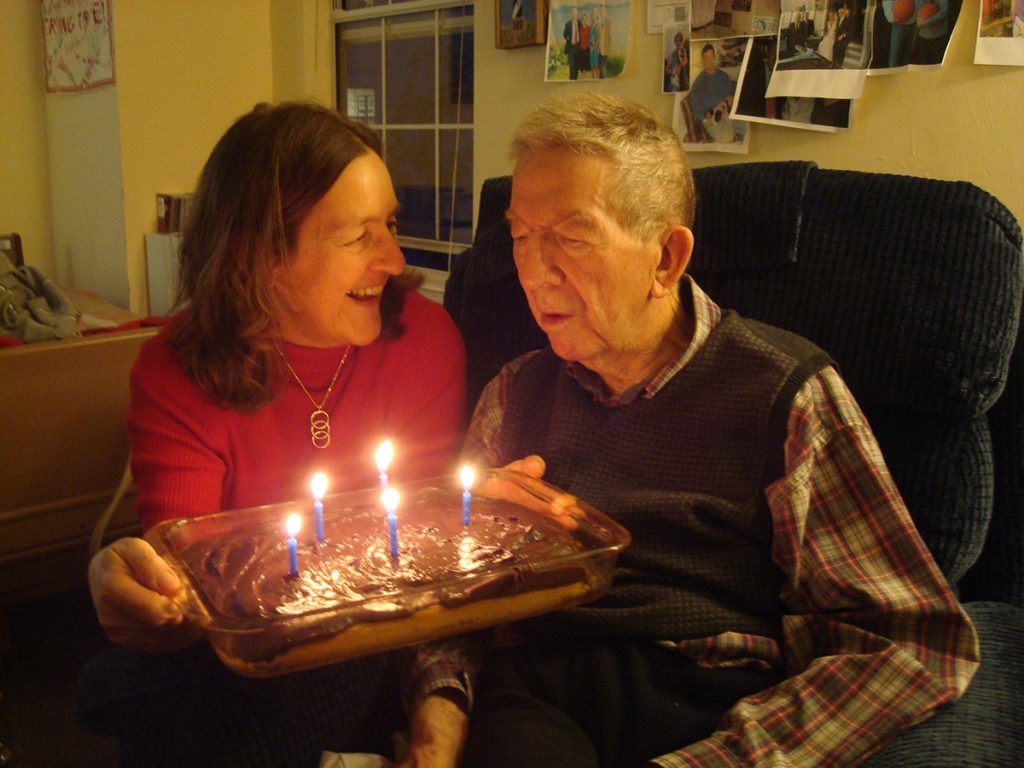
“Sitting and Observing, and Just Being With”
Susan moved her father from his nursing home in New Jersey to one in Tallahassee. Having him closer by, she thought, she would be able to better care for him. She couldn’t stop his disease, any more than she could protect the terns and oystercatchers on her island from their many threats. So she did what she could.
“Both of them were sort of meditative and required me to spend a lot of time sitting and observing, and just being with. And not necessarily being able to fix anything for either one. But my assignment was to stay the course and care for them as best I could. Both of them.”
The numbers can seem overwhelming. Over five million people in our country suffer from dementia, a term encompassing several diseases that gradually unmake the mind, such as Alzheimer’s and Parkinson’s. On the environmental front, North America has lost 70% of its shorebirds since 1970. And globally, we’ve lost 85% of our oyster reefs. Like Susan said, it’s hard to visualize that here at Bald Point, especially in the low tide shots I included in the video. But we’re not far from Apalachicola Bay. That bay had once provided 10% of our country’s wild harvest, but is now closing its crippled oyster fishery for five years, to allow it to recover.
What can one person do in the face of these losses, both globally and locally? Or against the unraveling of the mind? Watch, learn, and help where you can.
Being a Helper
“My father was what Mr. Rogers would call a helper.” Susan says. “He always had an eye out for someone that needed a hand.”
In Susan’s childhood home, that person was her mother. “My mother was subject to depression, as many women were in the 50s and 60s, with four little kids and a job. And that led to alcoholism.”
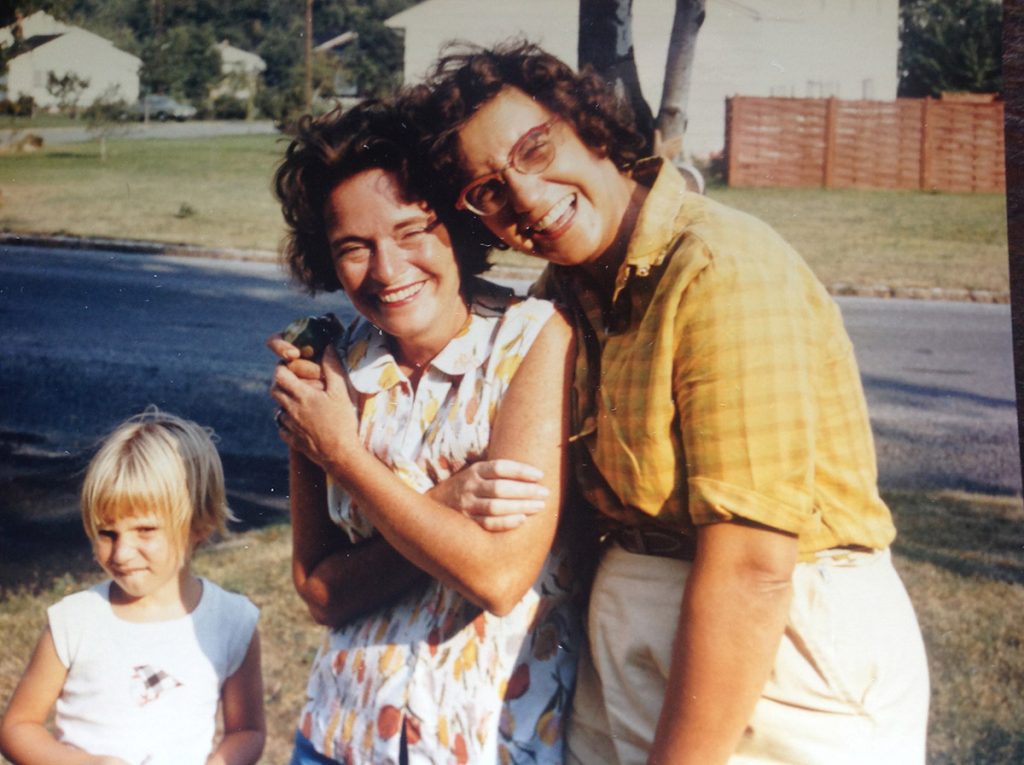
Her dad would enlist the children to do what they could to make it easier for her mom. “In the end, we weren’t able to save her. But we learned the impulse to look for where there was wounding, or hurt, and figure out a way to be useful.”
For Susan, that impulse led to a life dedicated to nature. On her unnamed spoil island, her job was to look after a small but important nesting site. She kayaked out from Apalachicola, and did her best to not spook the parent birds on her approach. Once there, she counted adults, found the nests and counted their eggs, and retreated quickly so that the parents could return to care for their unhatched young.
She then reported her findings to Florida Audubon. Part of helping vulnerable animals is gathering information about them, to better understand them and their needs, and get a better picture of their overall health in our area, and as a species.
“If somebody’s not watching, and reporting back to the rest of us, then we don’t see it.”
What Do Nesting Shorebirds Need?
A couple of years ago, I produced a couple of segments on snowy plovers. They have a specific set of needs for a nesting site, needs which unfortunately clash with a human preference for living and vacationing on beaches.
“That’s the problem for shorebirds.” Susan says. “That’s why shore birds, and seabirds like the terns, that’s why they’re so at risk right now. Because they require beaches like this, and oyster bars to nest on.”
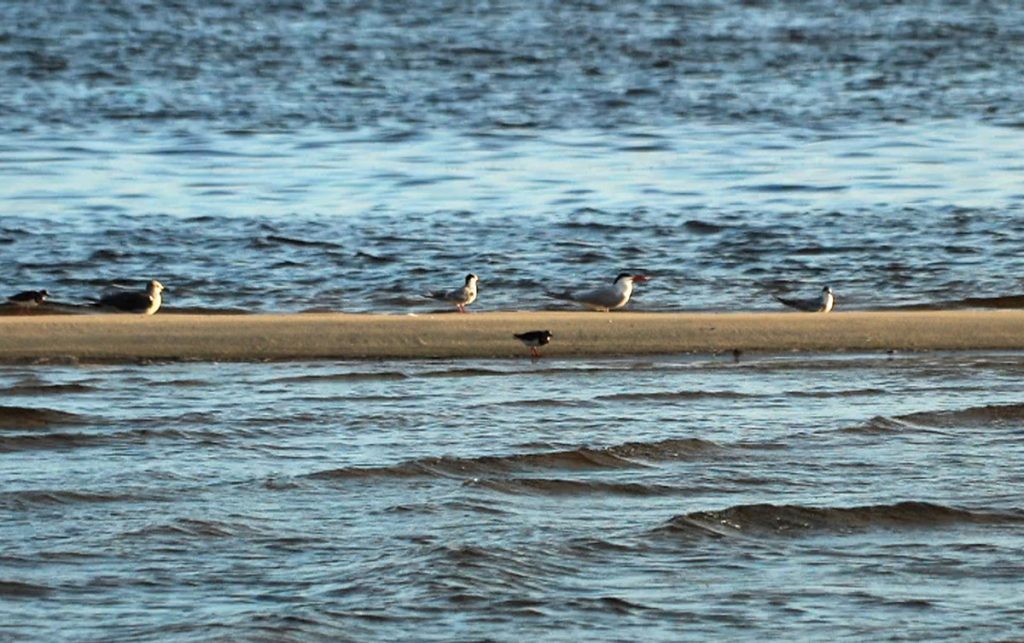
Aside from a willet poking the sand along the beach, most of the birds we see are on the point. To our right, and into Apalachee Bay, terns and gulls sit on a long sand bar that only connects to the beach at low tide. To the left is a hook of sand that makes a small bay around oyster reefs. At low tide, you can see a maze of oyster reefs along the Ochlockonee Bay side of the point.

The spit of sand to the left would be an ideal oystercatcher nesting site, Susan says, save for the regular human traffic. But we see oystercatchers here, so such a nesting spot exists somewhere in or near the park. They also nest on the Phipps Preserve, down the road at Alligator Point.
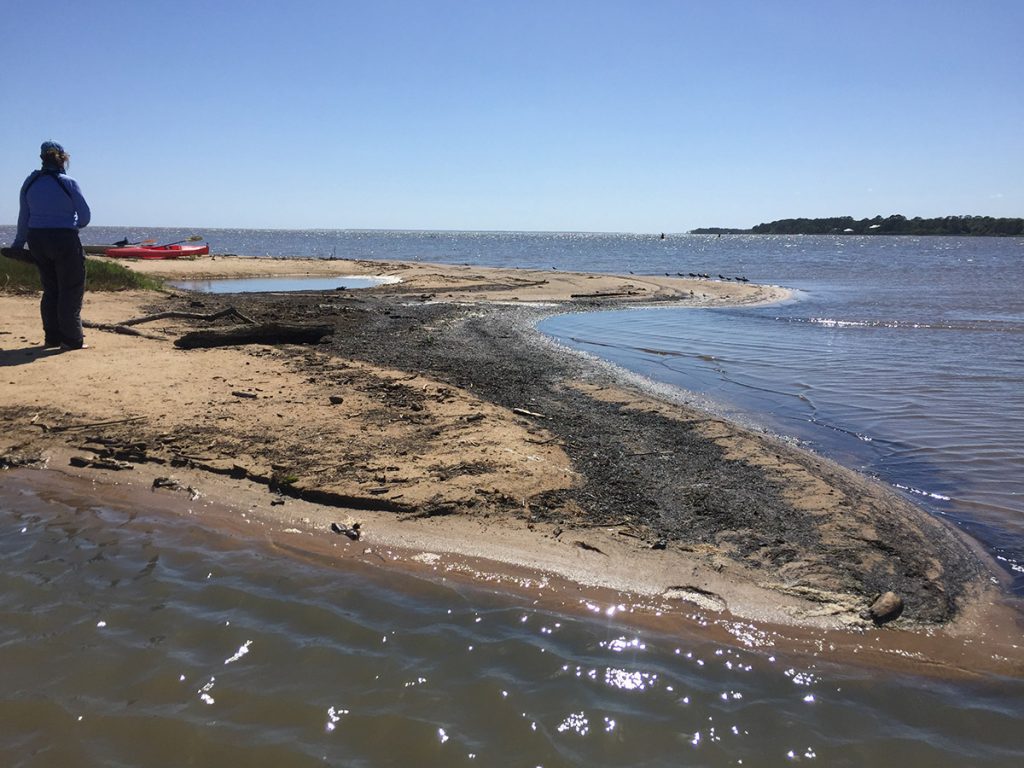
Oystercatcher Nesting
Susan goes into more detail about what oystercatchers need. Least terns and American oystercatchers nest in places that look otherwise unremarkable, showing little obvious value to those who don’t know what they’re looking at.
“They need to kind of have space to see what’s coming, and drive it off if they can. And that’s why a little island is good, because the mid-sized mammals have a tougher time swimming out there to get the eggs.”
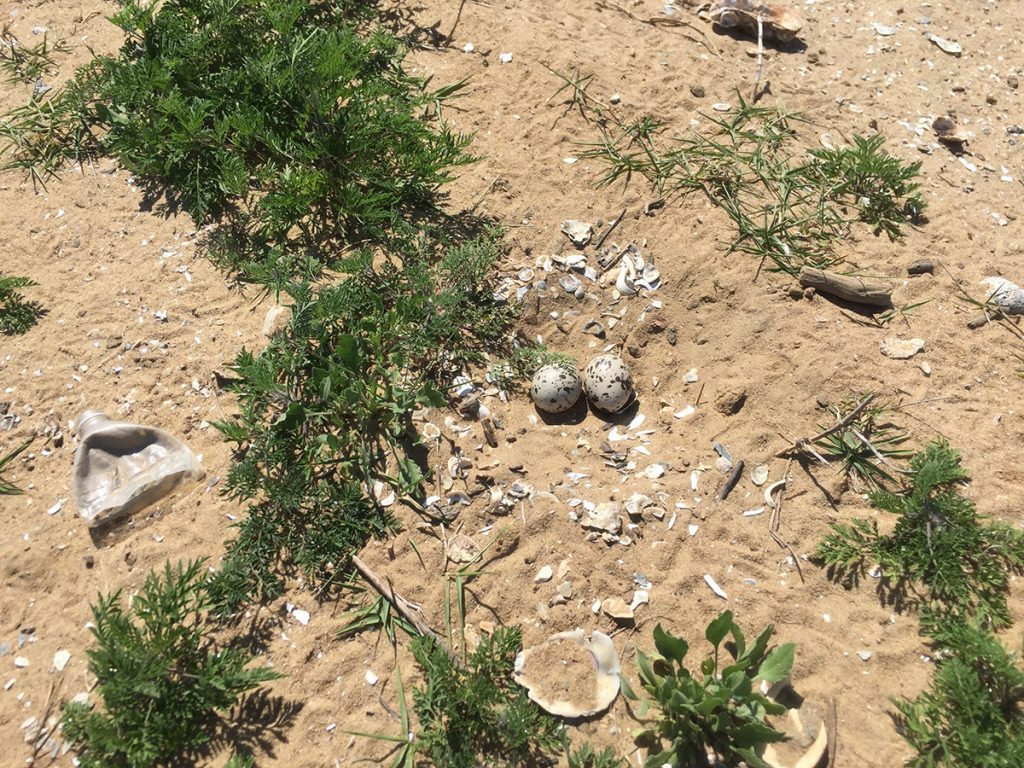
Many shorebirds lay their eggs directly on the sand, with minimal adornment around them. It’s an easy thing for humans to miss. While snowy plover nests are roped off along crowded beaches, like at Deer Lake State Park, no such marking exists on every flat, featureless island in a bay. In her book, she describes an instance where careless kayakers visited her island between surveying trips, with unhappy results.
Shorebirds need more than just the plot of sand or oysters on which they sit. The closure of Apalachicola Bay highlights this. The bay has been suffering since a prolonged drought (and the subsequent holding back of water at the Woodruff Dam by the Army Corps of Engineers) deprived the estuary of the fresh water it needed.
“They need a healthy bay. They need a healthy estuary that has these kinds of oyster reefs that we’re looking at, and all the little invertebrates that live in those oyster reefs. And, clean water. So they kind of need the same things we do. They definitely do.”
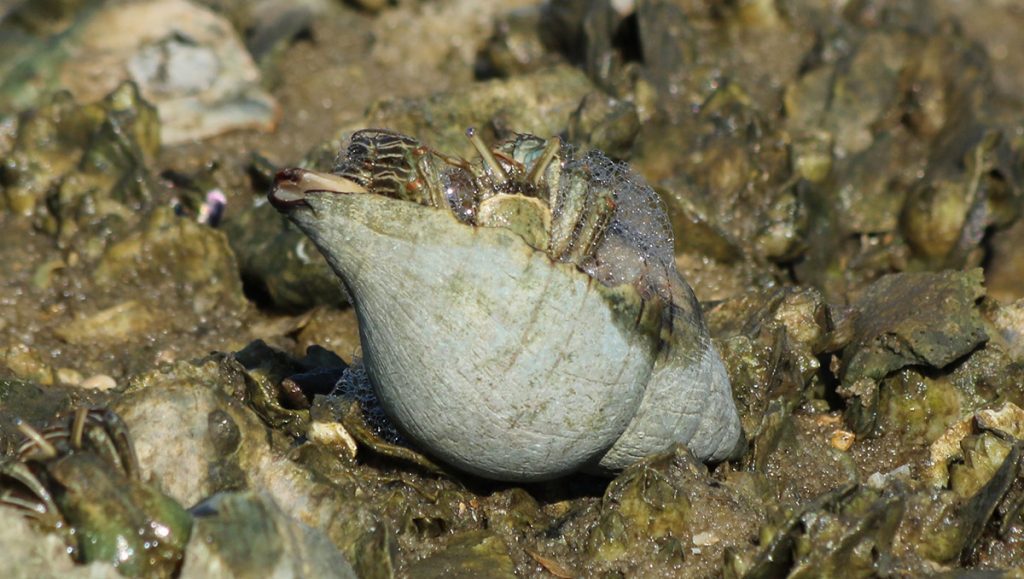
“We’re on our own, but we are billions.”
After she had taken care of her father’s basic needs, Susan came to terms with the finality of his disease.
“No matter what we all do, the course of this disease has an endpoint, and that’s death. And so I had to change my goals, or my sense of my abilities. I couldn’t save him. But I could care for him.”
Dementia has that one final endpoint. But despite the continuing impacts of habitat loss and climate change, Susan holds out hope that it’s not too late for our planet.
“It follows that we can mitigate to some extent the damage to climate and biodiversity.” She reads from her book. “But the work has to start now, and it has to be swift. The systems of power that have done the damage will not lead, nor should they be allowed. We’re on our own, but we are billions.”
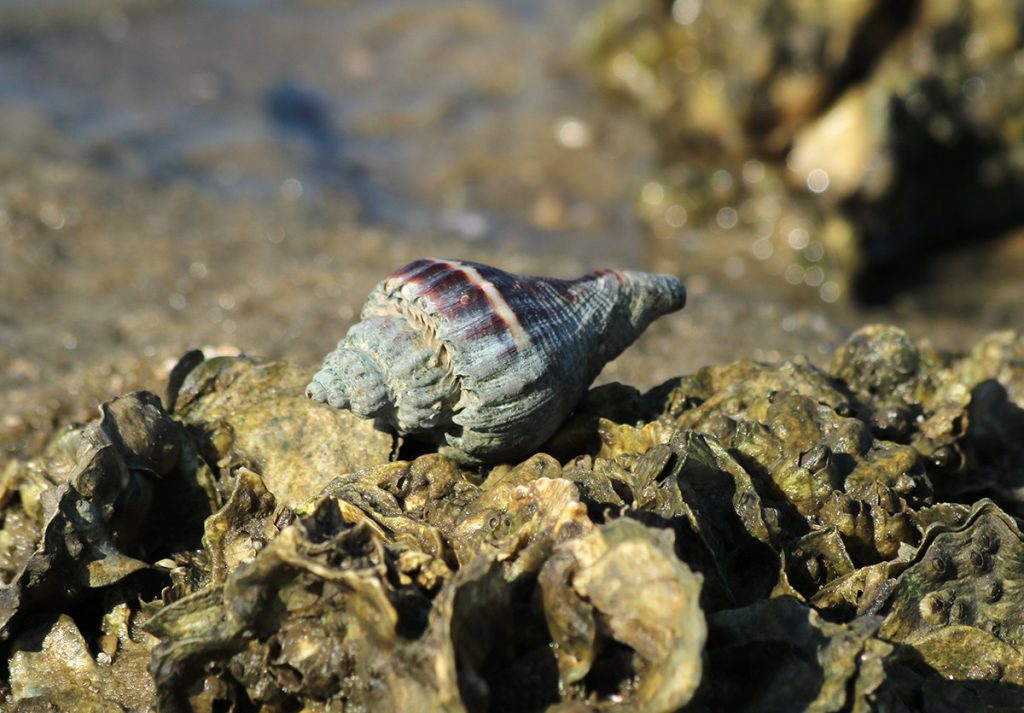
Helping the Natural World Through Citizen Science
There are endless ways to do even a little something to offset the damages to out natural systems. One that I always push on the blog is planting native, and allowing for wildlife in our yards.
Another way, and one that can be incorporated into your outdoor recreation if you’re into wildlife watching, is citizen science. Susan, for instance, volunteered to monitor vulnerable shorebird species. But even if you don’t have a kayak, or are not able to travel far from home, you have a few options. Each of these programs collects valuable data for researchers, and furthers our understanding of the natural world and the threats facing it.
“There are lots of ways that birds are tracked.” Susan says. “The Florida Shorebird Alliance has breeding bird counts for shorebirds. There are Christmas Bird Counts that have been taking place for over a hundred years.” Many consider the Audubon Christmas Bird Counts to be the original citizen science initiative.
“Then there’s things like iNaturalist that I know you’ve been involved in.” The free app has been a big part of the blog since last year’s EcoCitizen Project. It’s a plant and animal ID tool, while feeding your observations and identifications to a number of databases used by researchers.
That’s one of my favorite things about citizen science: you invariably learn something about that which you study. Check out our list of citizen science projects, which includes a site that helps you search for projects, and of course the locally based Coastal Plains Institute.
iNaturalist plant feature: Sandhill Wireweed
After Susan left, I filmed footage for a little bit, and took some photos. I became interested in the plants growing on and around the dunes at Bald Point, and snapped a few pics for iNaturalist. I found that one of the plants was a Florida endemic, meaning it’s found nowhere outside our state. And it’s more common on the peninsula than here in the panhandle. So I thought it would be fun to feature here at the end of the post.
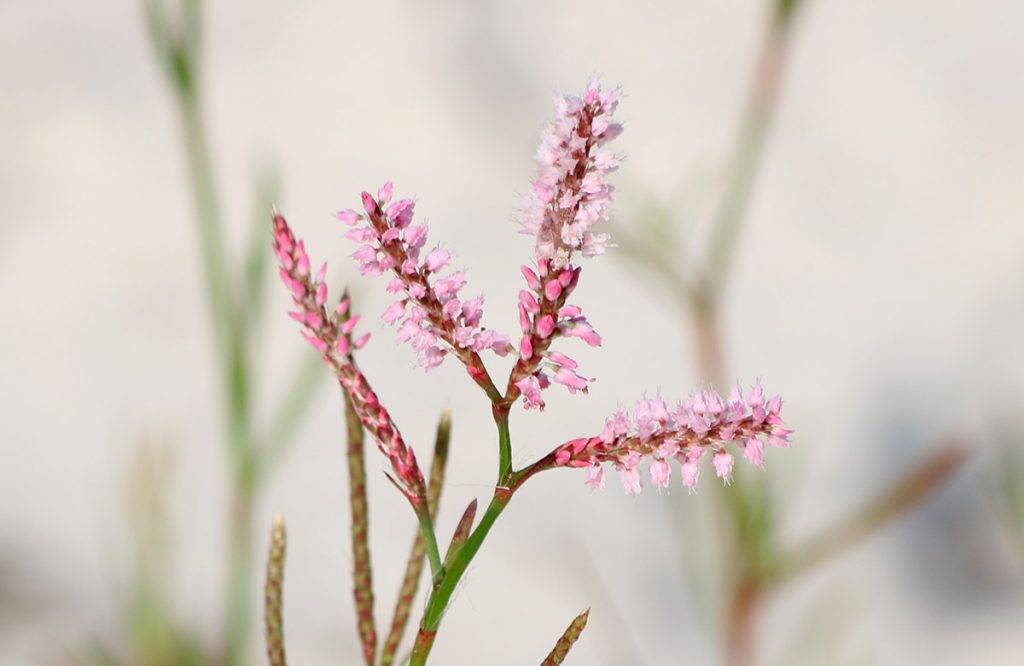
So, through iNaturalist, I’ve learned about this Florida native plant, which feeds bees in sandy environments: sandhills, scrub, and dunes. I’ve also added a location to the database, in a part of Florida where it’s less common.
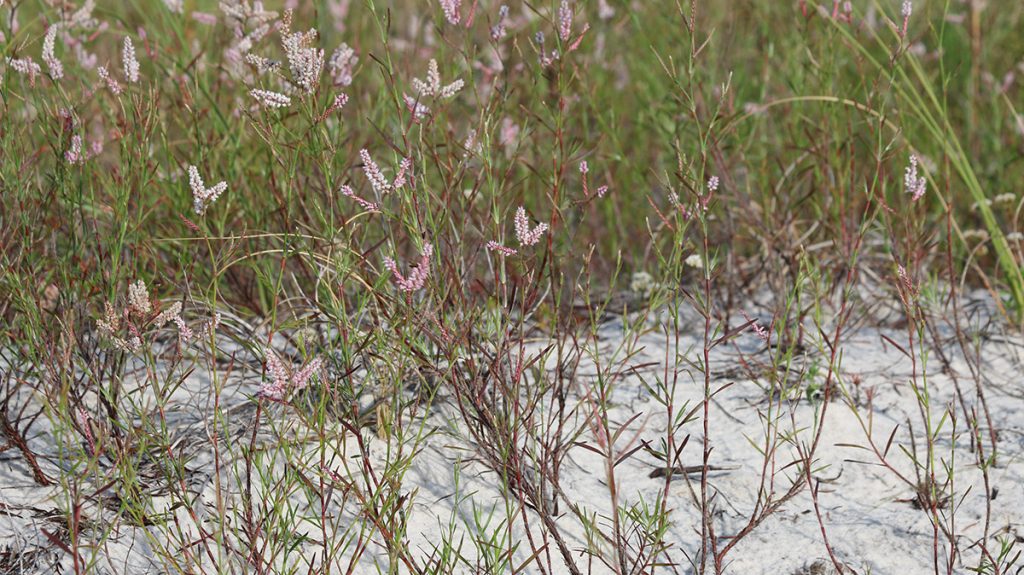
So there you have it: Sandhill wireweed.
Visiting Bald Point State Park
I like this park for a couple of different reasons. One is that, unlike much of Florida’s Forgotten Coast, its beaches face directly east. Here, you can watch the sun rise right out of Apalachee Bay. The park opens at 8 am, so unless you’re a State Park Annual Pass holder, you’ll have to park at the Sunrise Beach Access outside the gates of the park.
If you come to watch birds, you’ll want to check the tides first. Florida Audubon’s Bonnie Samuelson recommends the hours after high tide to watch birds on a beach, as they come to feed in the wet sand and in any seagrass wrack or small pools left behind by the retreating waves. I like watching the intertidal oyster reefs myself. If you come an hour or two before low tide, you’ll have a fair amount of time to see exposed oysters, and the many birds, crabs, predatory snails, and other invertebrates that make use of the ecosystem.
The park’s first entrance is easy to miss off of Alligator Drive, but this is where you go to access the boat ramp at Tucker Lake. The lake is connected to Ochlockonee Bay by Chaires Creek. You can learn more about it in our post from a couple of years ago, when we kayaked Chaires Creek with the Apalachicola Riverkeeper team. There are oyster reefs at the mouth of the creek, so you’ll want to time your trip with the tides, so you have enough water to make it there and back (or across the Bay, if the weather’s good). Doug Alderson explains how to best sync with the tides in that post.
As you see in that video, the park is also a good place to see monarch butterflies gather before migrating across the Gulf to their wintering grounds Mexico. October is the peak month for that. We also saw overwintering ducks that day, fishing around the oyster reefs and salt marshes.
